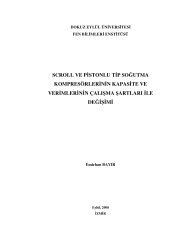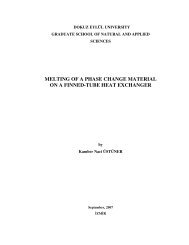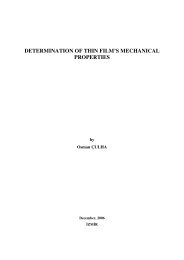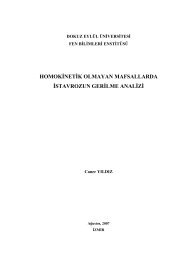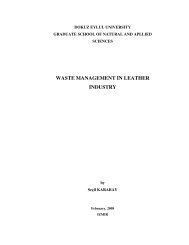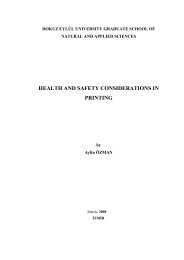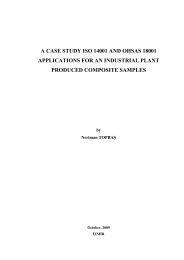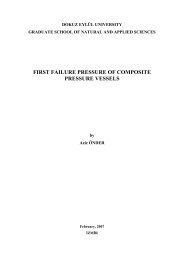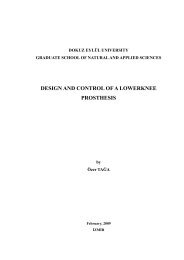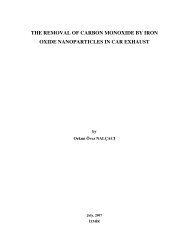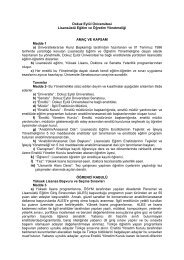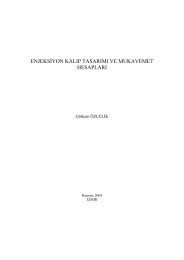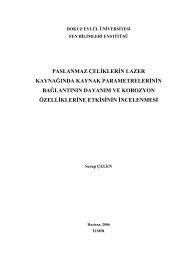A numerical study on the thermal expansion coefficients of fiber
A numerical study on the thermal expansion coefficients of fiber
A numerical study on the thermal expansion coefficients of fiber
Create successful ePaper yourself
Turn your PDF publications into a flip-book with our unique Google optimized e-Paper software.
12<br />
Metals are str<strong>on</strong>g and tough. They can be plastically deformed and streng<strong>the</strong>ned<br />
by a wide variety <strong>of</strong> methods. Metal matrix composite c<strong>on</strong>structi<strong>on</strong> is used<br />
primarily to increase <strong>the</strong> strength <strong>of</strong> low density metals such as aluminum alloys,<br />
copper, titanium alloys and magnesium alloys. Ano<strong>the</strong>r reas<strong>on</strong> for c<strong>on</strong>structing<br />
MMCs is to increase <strong>the</strong> wear resistance and higher temperature performance. The<br />
matrix material can be reinforced with c<strong>on</strong>tinuous <strong>fiber</strong>s and wires or by short <strong>fiber</strong>s,<br />
whiskers or particles. The complex nature <strong>of</strong> <strong>the</strong>se materials and <strong>the</strong>ir manufacture<br />
limits <strong>the</strong>ir use to high performance applicati<strong>on</strong>s, in industries such as, automotive,<br />
aerospace, and power. Some <strong>of</strong> <strong>the</strong> comm<strong>on</strong>ly used reinforcing materials are<br />
bor<strong>on</strong>/tungsten, titanium, alumina, graphite and silic<strong>on</strong> carbide.<br />
Particle or disc<strong>on</strong>tinuously reinforced MMCs have become very important<br />
because <strong>the</strong>y are less expensive than c<strong>on</strong>tinuous <strong>fiber</strong> reinforced composites and <strong>the</strong>y<br />
have relatively isotropic properties compared to <strong>fiber</strong> reinforced composites. Use <strong>of</strong><br />
nanometer-sized fullerenes (a form <strong>of</strong> carb<strong>on</strong> having a large molecule c<strong>on</strong>sist <strong>of</strong> an<br />
empty cage <strong>of</strong> sixty or more carb<strong>on</strong> atoms, C 60 is <strong>the</strong> most comm<strong>on</strong>) as a reinforcement<br />
has also been tried.<br />
2.2.1.3 Ceramic Matrix Materials<br />
Generally, ceramics c<strong>on</strong>sist <strong>of</strong> <strong>on</strong>e or more metals combined with a n<strong>on</strong>metal<br />
such as oxygen, carb<strong>on</strong> or nitrogen. They have str<strong>on</strong>g covalent and i<strong>on</strong>ic b<strong>on</strong>ds.<br />
Ceramic materials in general have a very attractive package <strong>of</strong> properties such as<br />
high strength and high stiffness at very high temperatures, chemical inertness, and<br />
low density. This attractive package is defaced by <strong>on</strong>e deadly defect; lack <strong>of</strong><br />
toughness. They are extremely susceptible to <strong>the</strong>rmal shock and are easily damaged<br />
during fabricati<strong>on</strong> and/or service. It is <strong>the</strong>refore understandable that an overriding<br />
c<strong>on</strong>siderati<strong>on</strong> in ceramic matrix composites is to toughen <strong>the</strong> ceramics by incorporating<br />
<strong>fiber</strong>s in <strong>the</strong>m and thus exploit <strong>the</strong> attractive high-temperature strength and<br />
envir<strong>on</strong>mental resistance <strong>of</strong> ceramic materials without risking a catastrophic failure.<br />
There are certain basic differences between CMCs and o<strong>the</strong>r composites. The general<br />
philosophy in n<strong>on</strong>ceramic matrix composites is to have <strong>the</strong> <strong>fiber</strong> bear a greater



